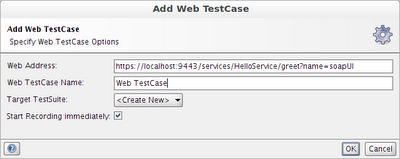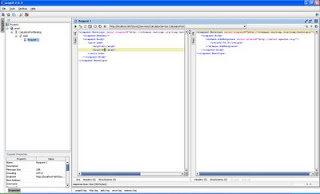How to secure a SOAP web service in WSO2 Application Server and invoke it using HTTP basic authentication with soapUI
In a previous blog post, I explained the steps to deploy a web service in Apache Axis2, secure it with HTTP basic authentication and invoke it using Apache Jmeter. In this post, we will repeat the same using different set of tools and frameworks which are comparatively easy-to-use and user-friendly.
We will secure a simple SOAP based web service which is hosted in WSO2 Application Server, configure an authentication security policy and invoke the service using HTTP basic auth through soapUI.
Pre-Requisites:
Download and install WSO2 Application Server-5.0.0
Download and install soapUI 4.0.1 or later version
Step 1:
Start WSO2 Application Server by running wso2server.sh startup script. Access the management console url (https://localhost:9443/carbon) and log in with the default administrator credentials (username=admin, password=admin)
Step 2:
Go to the Deployed Services page and you will find "HelloService" is deployed by default. Click on the service and go the the service dashboard. Click on Security to configure a security policy for the service. You will find the default set of security policies in the Security for the service page. In order to protect the service with HTTP basic authentication, we can configure Usernametoken security scenario. Username token security policy secures the service using username and password. Select UsernameToken security scenario and click on Next. Select admin as the user group which need to be authenticated. Click Finish to complete the security policy configuration.
Step 3:
Now, if you check the WSDL of the web service, you will see a WS-Security policy is added to the WSDL. Therefore, if you send a SOAP request, it must include the necessary WS-Security headers.
You can read one of my previous blog posts to see how you can send a secure SOAP request to a service using soapUI.
The beauty of WSO2 Application Server is, it allows you to send a HTTP GET request with basic authentication headers to the same web service. Let's see how we can send a HTTP GET request to invoke the above HelloService which has been secured with Username Token security policy.
Step 4:
Open soapUI. Click on File --> New soapUI Project. Enter a name for the project. Select Create Web TestCase option (We are not going to deal with any SOAP messages, therefore we do not want to create usual soapUI project using a WSDL). This will open Add Web TestCase dialog. Enter the following URL as the web address.
Web address = https://localhost:9443/services/HelloService/greet?name=soapUI
Note that, this is the url of the GET request which we are going to submit.
Step 5:
Once you click on OK in the above dialog, soapUI will open an HTTP request editor with the above request URL. Click on Request tab to move into the request editor if you ended up in the response tab.
Click on Aut tab where you can specify user credentials. Enter the following credentials of admin user which we used to secure HelloService at the step 2.
Username=admin
Password=admin
Step 6:
Before invoking the service, make sure Authenticate Preemptively option is selected at the HTTP Settings of soapUI Preferences dialog (File --> Preferences --> HTTP Settings --> Authenticate Preemptively).
Now, submit the request. You will see the following in the raw view of request.
GET https://localhost:9443/services/HelloService/greet?name=soapUI HTTP/1.1
Accept-Encoding: gzip,deflate
Authorization: Basic YWRtaW46YWRtaW4=
User-Agent: Jakarta Commons-HttpClient/3.1
Host: localhost:9443
And, the response will be similar to the following.
HTTP/1.1 200 OK
Content-Type: application/xml;charset=UTF-8
Transfer-Encoding: chunked
Content-Encoding: gzip
Vary: Accept-Encoding
Date: Thu, 20 Sep 2012 08:38:31 GMT
Server: WSO2 Carbon Server
Hello World, soapUI !!!
We will secure a simple SOAP based web service which is hosted in WSO2 Application Server, configure an authentication security policy and invoke the service using HTTP basic auth through soapUI.
Pre-Requisites:
Download and install WSO2 Application Server-5.0.0
Download and install soapUI 4.0.1 or later version
Step 1:
Start WSO2 Application Server by running wso2server.sh startup script. Access the management console url (https://localhost:9443/carbon) and log in with the default administrator credentials (username=admin, password=admin)
Step 2:
Go to the Deployed Services page and you will find "HelloService" is deployed by default. Click on the service and go the the service dashboard. Click on Security to configure a security policy for the service. You will find the default set of security policies in the Security for the service page. In order to protect the service with HTTP basic authentication, we can configure Usernametoken security scenario. Username token security policy secures the service using username and password. Select UsernameToken security scenario and click on Next. Select admin as the user group which need to be authenticated. Click Finish to complete the security policy configuration.
Step 3:
Now, if you check the WSDL of the web service, you will see a WS-Security policy is added to the WSDL. Therefore, if you send a SOAP request, it must include the necessary WS-Security headers.
You can read one of my previous blog posts to see how you can send a secure SOAP request to a service using soapUI.
The beauty of WSO2 Application Server is, it allows you to send a HTTP GET request with basic authentication headers to the same web service. Let's see how we can send a HTTP GET request to invoke the above HelloService which has been secured with Username Token security policy.
Step 4:
Open soapUI. Click on File --> New soapUI Project. Enter a name for the project. Select Create Web TestCase option (We are not going to deal with any SOAP messages, therefore we do not want to create usual soapUI project using a WSDL). This will open Add Web TestCase dialog. Enter the following URL as the web address.
Web address = https://localhost:9443/services/HelloService/greet?name=soapUI
Note that, this is the url of the GET request which we are going to submit.
Step 5:
Once you click on OK in the above dialog, soapUI will open an HTTP request editor with the above request URL. Click on Request tab to move into the request editor if you ended up in the response tab.
Click on Aut tab where you can specify user credentials. Enter the following credentials of admin user which we used to secure HelloService at the step 2.
Username=admin
Password=admin
Step 6:
Before invoking the service, make sure Authenticate Preemptively option is selected at the HTTP Settings of soapUI Preferences dialog (File --> Preferences --> HTTP Settings --> Authenticate Preemptively).
Now, submit the request. You will see the following in the raw view of request.
GET https://localhost:9443/services/HelloService/greet?name=soapUI HTTP/1.1
Accept-Encoding: gzip,deflate
Authorization: Basic YWRtaW46YWRtaW4=
User-Agent: Jakarta Commons-HttpClient/3.1
Host: localhost:9443
And, the response will be similar to the following.
HTTP/1.1 200 OK
Content-Type: application/xml;charset=UTF-8
Transfer-Encoding: chunked
Content-Encoding: gzip
Vary: Accept-Encoding
Date: Thu, 20 Sep 2012 08:38:31 GMT
Server: WSO2 Carbon Server




Comments